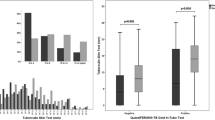Abstract
The main objective of this study is to determine the prevalence of positive and anergic tuberculin skin test (ppd) in a rheumatoid arthritis cohort of patients (RA) and assess the association among ppd results and clinical and treatment variables. Patients with RA diagnosis were included. The ppd was done by Mantoux method. Positive result was considered when indurations were equal or greater than 5 mm. Anergic reaction was defined when the indurations was 0 mm. We included 105 patients (N = 105). The prevalence of positive ppd was 12.4% (n = 13), while the 87.6% (n = 92) presented a negative result. The 69.5% (n = 73) of the population were anergic to ppd. Patients with negative result received higher steroids dosages than patients with positive ppd (p < 0.04). In the multivariable model, the steroids dosage was a significant and independent predictor of negative ppd (p = 0.021, OR 0.72, 95% CI 0.55–0.95). Anergic and non-anergic patients were separated in groups, and a new analysis was done. The higher dosage of methotrexate was associated to tuberculine anergy (p = 0.025). In the multivariable model, the methotrexate dosage was a significant and independent predictor of tuberculine anergy (p = 0.005, OR 1.14, 95% CIs 1.04–1.24). In conclusion, in our cohort, the prevalence of positive ppd was lower than others studies. Among analyzed variables, the high steroid dose was a significant and independent predictor of negative ppd. The methotrexate treatment and dose were associated with ppd anergy.
Similar content being viewed by others
References
Furst DE, Schiff MH, Fleischmann RM, Strand V, Birbara CA, Compagnone D et al (2003) Adalimumab, a fully human anti tumor necrosis factor alpha monoclonal antibody, and concomitant estándar antirheumatic therapy for treatment of rheumatoid arthritis: results of STAR (Safety Trial of Adalimumab in Rheumatoid Artritis). J Rheumatol 30:2563–2571
Klareskog L, Van Der Heijde D, de Jager JP, Gough A, Kalden J, Malaise M et al (2004) Therapeutic effect of the combination of etanercept and methotrexate compared with each alone in patients with rheumatoid arthritis: double blinded randomised controlled trial. Lancet 343:1594–1602
Lipsky PE, Van der Heijde DM, St Clair EW, Furst DE, Breedvelved FC, Kalden JR et al (2000) Infliximab and methotrexate in the treatment of rheumatoid arthritis. Anti tumor necrosis factor trial in rheumatoid arthritis with concomitant therapy study group. N Engl J Med 342:763–769. doi:10.1056/NEJM200003163421103
Breedveld FC, Weisman MH, Kavanaugh AF, Cohen SB, Pavelka K, Van Vollenhoven R et al (2006) The Premier Study: a multicenter, randomized, double blind clinical trial of combination therapy with adalimumab plus methotrexate versus methotrexate alone or adalimumab alone in patients with early, aggressive rheumatoid arthritis who had not had previous methotrexate treatment. Arthritis Rheum 54:26–37. doi:10.1002/art.21519
Genovese MC, Bothon JM, Martin RW, Fleischmann RM, Tesser JR, Schiff MH et al (2002) Etanercept versus methotrexate in patients with early rheumatoid arthritis: two years radiographic and clinical outcomes. Arthritis Rheum 46:1443–1450. doi:10.1002/art.10308
Joseph K, Gershon S, Wise PR, Mirabile E et al (2001) Tuberculosis associated with infliximab, a tumor necrosis factor α-neutralizing agent. N Engl J Med 345:1098–1104. doi:10.1056/NEJMoa011110
Imperato A, Smiles S, Abramson SB (2004) Long-term risks associated with biologic response modifiers used in rheumatic diseases. Curr Opin Rheumatol 16:199–205. doi:10.1097/00002281-200405000-00006
Askling J, Fored CM, Brandt L, Baecklund E, Bertilsson L, Coster L et al (2005) Risk and case characteristics of tuberculosis in rheumatoid arthritis associated with tumor necrosis factor antagonists in Sweden. Arthritis Rheum 52(7):1986–1992. doi:10.1002/art.21137
Jacobs M, Togbe D, Fremond C et al (2007) Tumor necrosis factor is critical to control tuberculosis infection. Microbes Infect 9:623–628. doi:10.1016/j.micinf.2007.02.002
Hamdi H, Marieta X, Godoy V et al (2006) Inhibition of antituberculosis T Lymphocyte function with tumour necrosis factor antagonists. Arthritis Res Ther 8:R114
Obrador A, San Roman LA, Muñoz P, Gassull MA et al (2003) Guia de Consenso sobre tuberculosis y tratamiento de la enfermedad inflamatoria intestinal con infliximab. Gastroenterol Hepatol 26(1):29–33. doi:10.1157/13042212
Ledingham J, Wilkinson C, Deighton C (2005) British Thoracic Society recommendations for assessing risk and managing tuberculosis in patients due to Stara anti-TNF alpha treatments. Rheumatology 44:1205–1206. doi:10.1093/rheumatology/kei103
Furst DE, Breedveld FC, Kalden JR et al (2006) Updated consensus statement on biological agents for the treatment of rheumatic diseases, 2006. Ann Rheum Dis 65(suppl III):iii2–iii15. doi:101136/ard2006.061937
Corrigall VM, Garyfallos A, Panayi GS (1999) The relative proportions of secreted interleukin-2 and interleukin-10 determine the magnitude of rheumatoid arthritis T cell proliferation to the recall antigen tuberculin purified protein derivative. Rheumatol 38:1203–1207. doi:10.1093/rheumatology/38.12.1203
Loza E, Alen J, Canto F, Alarcon G (2005) Artritis Reumatoide. In: Ramos Casal M, Carrasco M, Salazar J (eds) Enfermedades Autoinmunes sistémicas y reumatológicas. Masson, Barcelona, pp 369–399
Fraser P (1999) Micobacterias. In: Fraser RS, Muller NL, Colman N, Pare PD (eds) Diagnóstico de las Enfermedades del tórax, Ed 4º. WD Sounders, Philadelphia, pp 790–866
Gil Germán, Neira O, Marcone P, Sabagh E (2006) Tuberculine reactivity in chilean RA patients (abstract). J Clin Rheumatol 12(Suppl 4):S8
Ponce de León D, Acevedo-Vásquez E, Sánchez-Torres A, Cucho M et al (2005) Attenuated response to purified protein derivative in patients with rheumatoid arthritis: study in a population with a high prevalence of tuberculosis. Ann Rheum Dis 64:1360–1361. doi:10.1136/ard.2004.029041
Matulis G, Juni P, Villiger PM et al (2008) Detection of latent tuberculosis in immunosuppressed patients with autoimmune diseases: performance of mycobacterium tuberculosis antigen-specific interferon assay. Ann Rheum Dis 67(1):84–90
Small PM, Fujiwara PI (2001) Management of tuberculosis in the United States. N Engl J Med 345(3):189–200
Author information
Authors and Affiliations
Corresponding author
Rights and permissions
About this article
Cite this article
Tamborenea, M.N., Tate, G., Mysler, E. et al. Prevalence of positive ppd in a cohort of rheumatoid arthritis patients. Rheumatol Int 30, 613–616 (2010). https://doi.org/10.1007/s00296-009-1027-z
Received:
Accepted:
Published:
Issue Date:
DOI: https://doi.org/10.1007/s00296-009-1027-z




